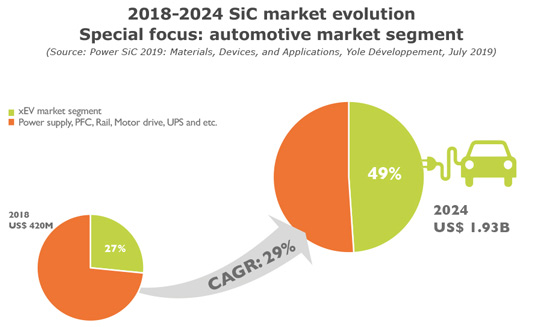- News
19 July 2019
Silicon carbide power device market growing at 29% CAGR to $1.93bn in 2024, driven by EV market
Based on discussions with leading silicon carbide (SiC) players, the Yole Group of companies sees a prospering SiC power device market, according to Yole Développement’s technology & market report ‘Power SiC: Materials, Devices, and Applications’, Knowmade’s patent landscape analysis ‘Power SiC: MOSFETs, SBDs and Modules’ and System Plus Consulting’s detailed reverse engineering comparison ‘SiC MOSFET Comparison’.
“The SiC power semiconductor market’s value will approach $2bn by 2024,” says Hong Lin PhD, principal analyst, Compound Semiconductor at Yole. “This market is showing an impressive 29% CAGR [compound annual growth rate] between 2018 and 2024. And, we announced last year, the automotive market is undoubtedly the foremost driver, with around 50% of total device market share in 2024.”
The primary market driver is the automotive sector, notes Yole. The total automotive market is expect to reach about $1bn in 2024 (49% market share). SiC is already used in on-board chargers (OBCs) and such applications will be widely developed in the coming years, it is reckoned.

“The 2018–2019 period is showing a strong shift for SiC adoption by the automotive industry for its main inverter application,” comments Yole’s Hong Lin. “With the implementation of SiC technology by Tesla, the market has reached the point of no return, and discussions concerning whether other automotive players will also adopt (or not) is THE topic of the year.” Following Tesla, BYD will release a SiC invertor in small serial production in 2019. Little by little, the main inverter will begin to adopt SiC, it is expected.
Recently, the automotive industry has committed more than $300bn investment towards hybrid and electric vehicle (xEV) development, causing the xEV market to explode. This is in stark contrast to the traditional combustion engine car market, which is suffering through a slowdown. The xEV market is the primary market driver for silicon power devices, and it is a source of excitement for SiC.
Ranging from conservative to optimistic, industrial players offer very different forecasts in terms of market value for SiC in the xEV market, ranging from several hundred million dollars to $3bn in 2025 (the latter estimated by STMicroelectronics).
Everyone agrees that EV is the market with the highest potential but - based on the data that each player has collected and the arguments that derive from their interpretation of the data - perceptions differ regarding how it will grow and how SiC will penetrate into the automotive market.
Behind the adoption of SiC, Yole highlights the packaging issue. The number of automotive-qualified module suppliers is still limited. According to Yole, only STMicroelectronics and Danfoss have expertise, and many challenges are still pending at this level of the SiC supply chain, so that full-SiC module have just begun a long journey.
“The technical panorama of SiC transistors devices is still varying. Concerning die design on the market we still can find different solution such as JFET and MOSFET and, among the latest, trench and planar structures,” explains Amine Allouche, costing analyst at System Plus Consulting. “Moreover, in term of packaging, since the standard packaging is not yet optimized for SiC’s higher performance, new designs and material are continuously being introduced. This leads to the entrance of new players, especially OSAT [outsourced semiconductor assembly & test], in the packaging’ sector.”
A study of the SiC patent landscape confirms the leadership of Japanese companies in power SiC devices, as well as significant penetration into the automotive industry.
“In recent years we have seen major players such as GE, Toyota Motor and Rohm accelerating their IP [intellectual property] activity in the field of SiC power devices,” notes Rémi Comyn, technology & patent analyst at Knowmade. Knowmade’s report also points out the presence of new IP players such as Hestia Power in Taiwan developing planar junction barrier Schottky (JBS) diode-integrated MOSFET technology and, more recently, Danfoss focusing on full-SiC power modules. “Chinese companies have been very active as well lately, with numerous newcomers such as CRRC Times Electric, SGCC and Century Goldray.”


